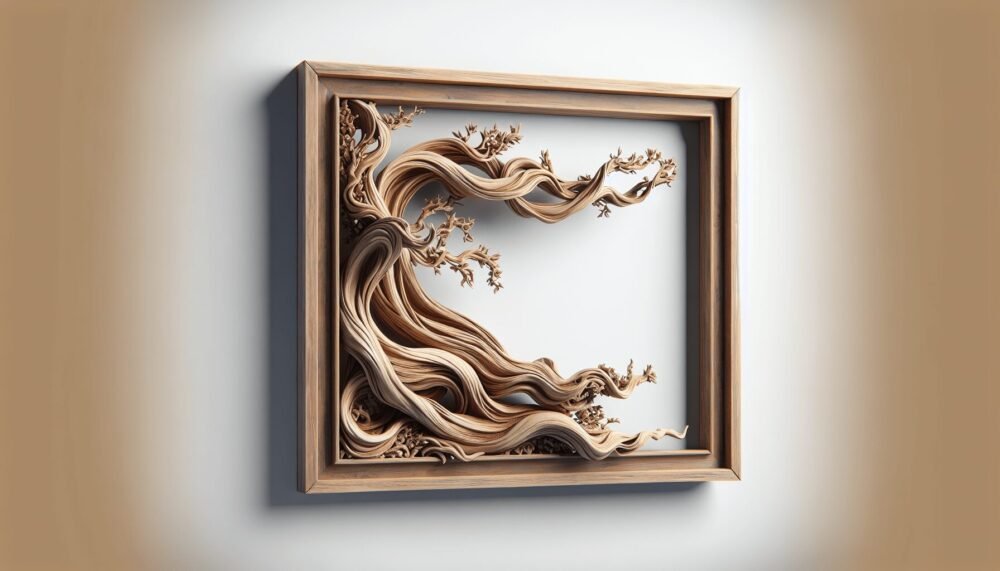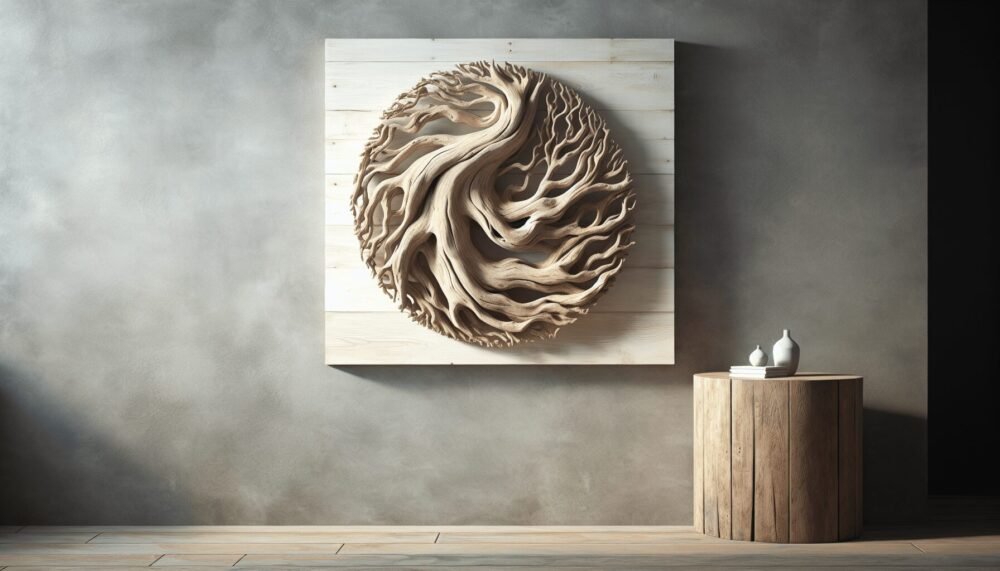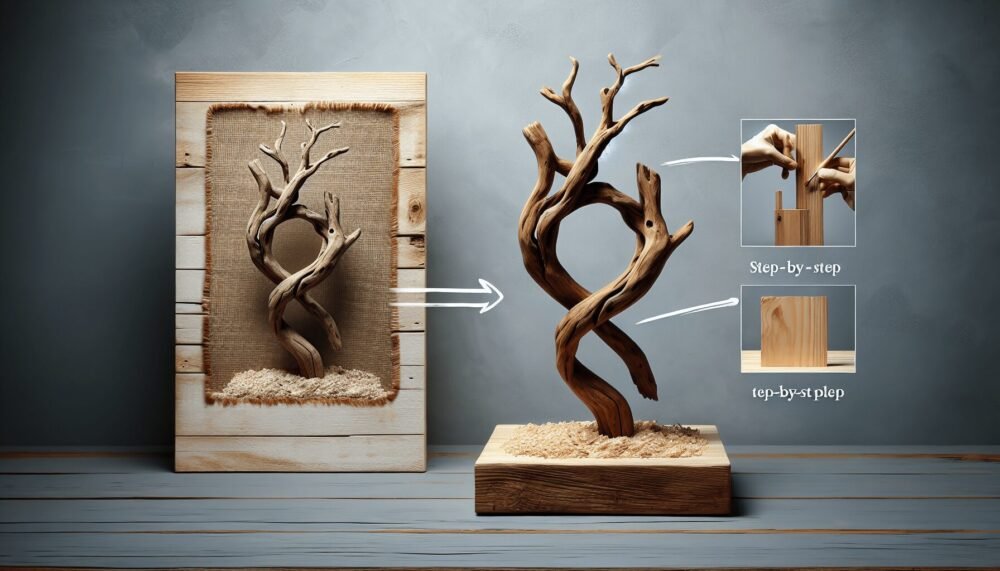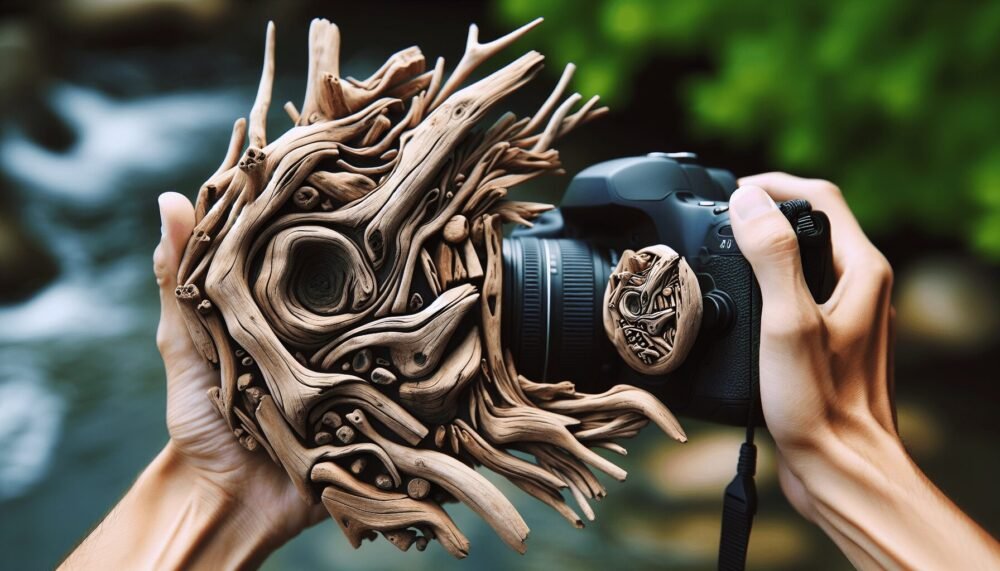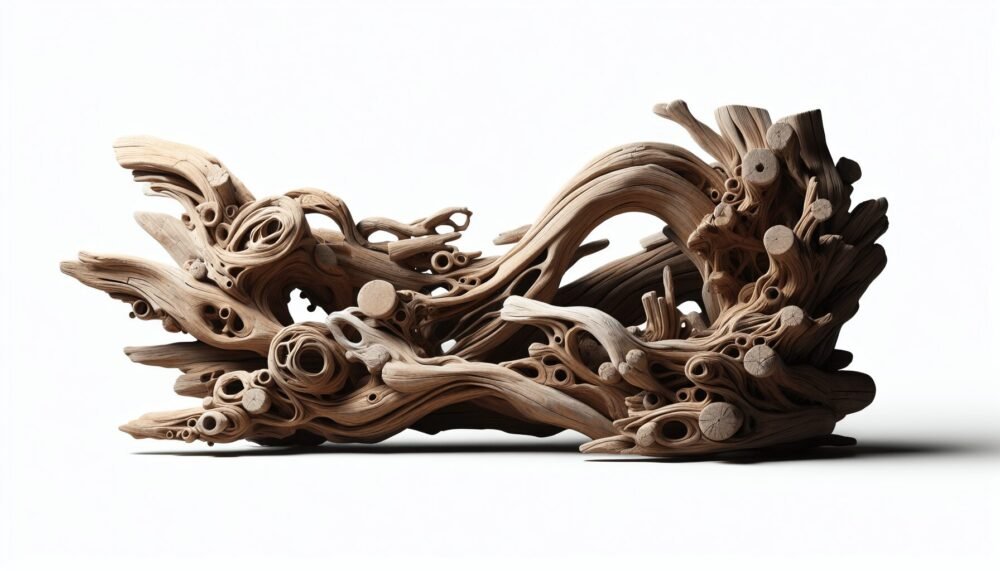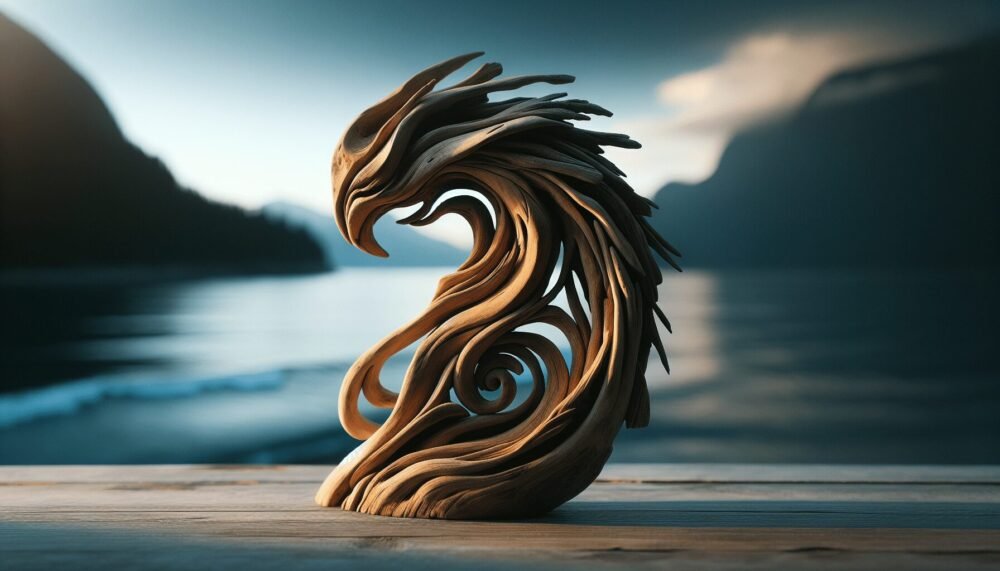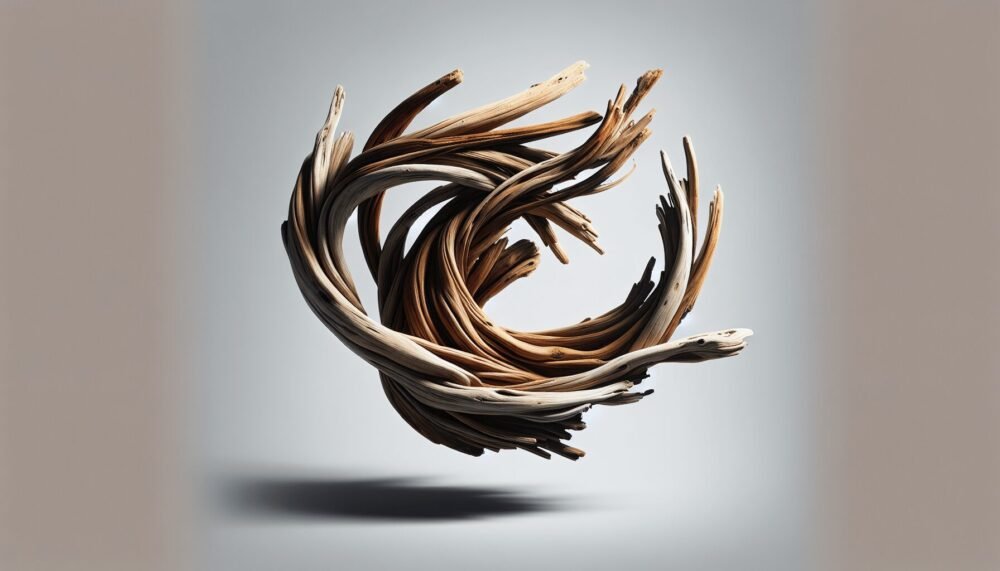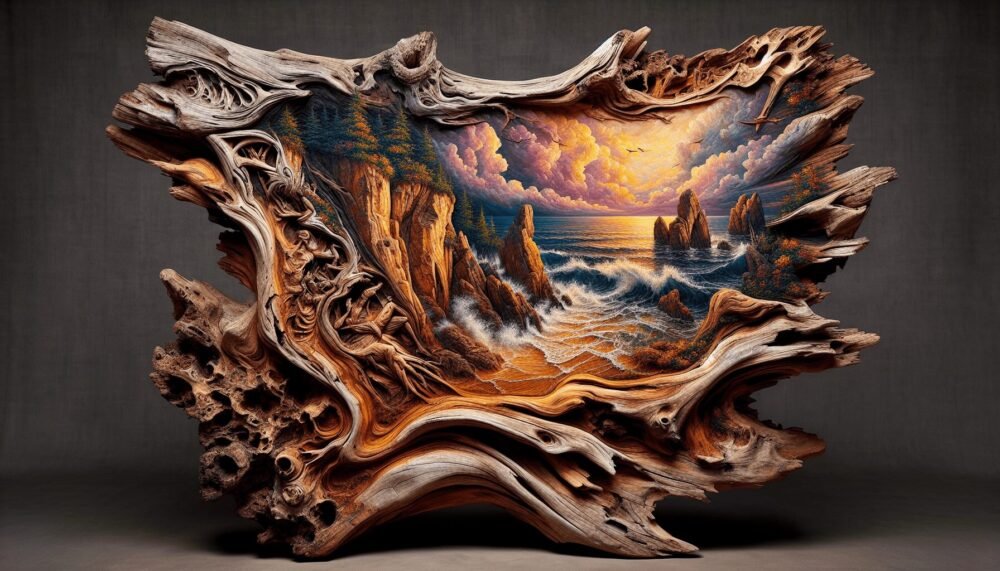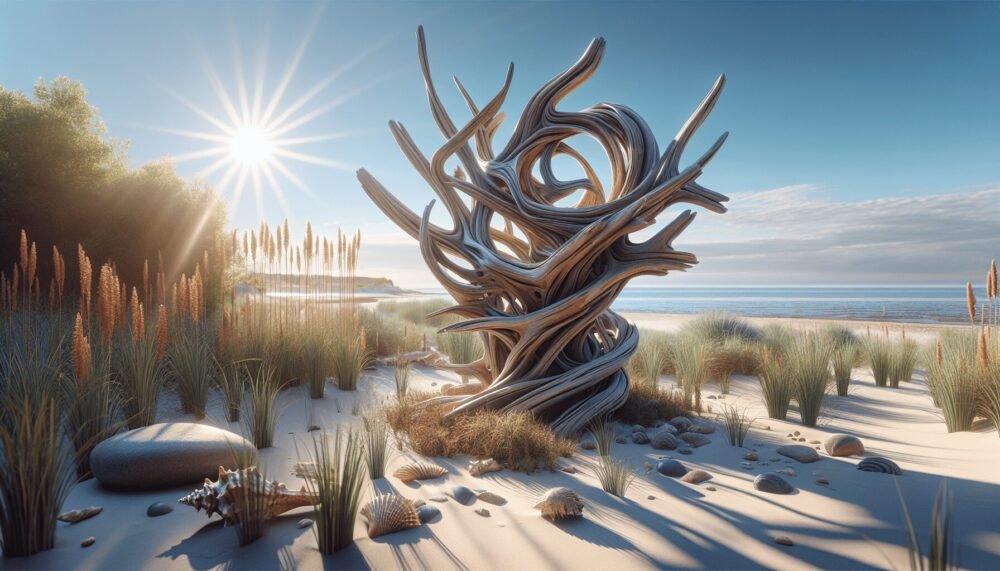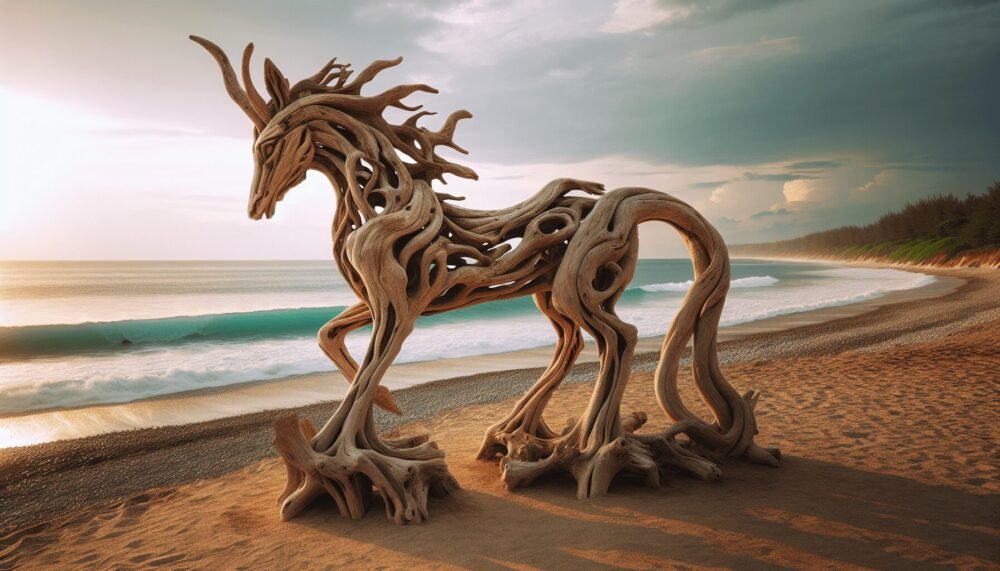Imagine being transported to a beachfront paradise where beautiful pieces of art are created from the remains of nature’s creations. Driftwood Art Sculpture Artworks is a stunning collection of unique artworks crafted entirely from driftwood, showcasing the intricate beauty and intricate imagination of its creator. Each piece captures the essence of the ocean, harnessing its wild spirit and eternal grace. Offering a glimpse into the wonders that driftwood art can create, this collection invites you to explore the artistic treasures that lie within nature’s discarded gems.
Introduction to Driftwood Art Sculpture
Driftwood art sculpture is a unique and captivating form of artwork that utilizes the natural beauty and texture of driftwood to create stunning sculptures. This art form involves carving, shaping, and assembling various pieces of driftwood to create intricate and eye-catching sculptures. The organic and weathered appearance of the driftwood lends itself perfectly to creating beautiful and one-of-a-kind art pieces.
What is driftwood art sculpture?
Driftwood art sculpture refers to the practice of transforming pieces of driftwood into artistic sculptures. Driftwood is wood that has been washed up on the shores of rivers, lakes, or oceans by the action of winds, tides, or waves. This natural process of erosion and weathering gives driftwood a unique character and charm that makes it an ideal material for creating art.
History and origins of driftwood art sculpture
The origins of driftwood art sculpture can be traced back to ancient times when people discovered the possibilities of using driftwood to create decorative and functional objects. In many coastal communities, people started using driftwood they found on beaches to build shelters, fences, and other practical items. Over time, artists began to recognize the artistic potential of driftwood and started using it to create sculptures.
Materials and tools used in driftwood art sculpture
One of the defining features of driftwood art sculpture is the use of natural materials. Apart from the driftwood itself, artists may use additional materials such as sand, stones, shells, and other found objects to add depth and texture to their sculptures. As for tools, artists typically use a combination of hand tools, such as chisels, files, and sandpaper, to shape and refine the driftwood. Power tools, such as chainsaws and drills, may also be employed for larger and more intricate pieces.
Techniques and Styles in Driftwood Art Sculpture
Carving and shaping driftwood
Carving and shaping driftwood is one of the fundamental techniques used in driftwood art sculpture. Artists carefully carve away and shape the driftwood to create intricate details or smooth flowing lines. This technique allows for the creation of sculptures that range from delicate and intricate to bold and geometric.
Assemblage and found object sculpture
Another technique commonly used in driftwood art sculpture is assemblage. Artists may gather various pieces of driftwood and other found objects, such as shells, stones, or even discarded metal, and assemble them into unique and visually striking sculptures. This technique adds an element of creativity and playfulness to the artistic process.
Abstract and figurative driftwood art
Driftwood art sculpture encompasses a range of styles, including abstract and figurative. Abstract driftwood sculptures emphasize form, texture, and the inherent beauty of the driftwood itself. These sculptures often evoke a sense of mystery and evoke a wide range of emotions. Figurative driftwood art, on the other hand, focuses on representing recognizable forms, such as animals, humans, or natural objects. These sculptures can capture the grace and essence of their subjects while also showcasing the distinctive characteristics of driftwood.
Indoor and outdoor driftwood sculptures
Driftwood art sculptures can be displayed both indoors and outdoors, making them versatile additions to any space. Indoor sculptures can serve as unique statement pieces that add visual interest and a touch of nature to interior design. The natural textures and organic shapes of driftwood sculptures create a warm and inviting ambiance. Outdoor sculptures, on the other hand, can enhance the beauty of gardens, patios, and other outdoor spaces. These sculptures blend seamlessly with the natural surroundings, creating a harmonious and calming atmosphere.

Famous Driftwood Art Sculpture Artists
Edward Wohl
Edward Wohl is a highly acclaimed driftwood art sculpture artist known for his intricate and detailed sculptures. His work encompasses both abstract and figurative forms, often incorporating elements of movement and balance. Wohl’s sculptures are characterized by their graceful lines and organic shapes, which he achieves through his masterful manipulation of driftwood.
Deborah Butterfield
Deborah Butterfield is renowned for her sculptures that depict horses, crafted primarily from driftwood. Her sculptures capture the beauty and spirit of these majestic animals, utilizing the natural form and texture of the driftwood to create an intimate and lifelike representation. Butterfield’s work showcases the harmonious relationship between nature and art, drawing viewers into a world of natural wonder.
Jeff Uitto
Jeff Uitto is a driftwood art sculpture artist celebrated for his ability to transform reclaimed driftwood into stunning and imaginative sculptures. With a keen eye for finding the perfect pieces of driftwood, Uitto creates intricate and detailed sculptures that often incorporate elements of marine life, wildlife, and fantasy. His work demonstrates the endless possibilities that exist within the medium of driftwood.
Heather Jansch
Heather Jansch is known for her remarkable sculptures of horses, made entirely from driftwood. Her sculptures capture the essence and movement of these elegant creatures, harnessing the organic beauty of driftwood. Jansch’s distinct style and meticulous attention to detail have earned her recognition as one of the leading driftwood art sculpture artists in the world.
Inspiration and Themes in Driftwood Art Sculpture
Natural and organic forms
The natural shapes and textures of driftwood serve as a constant source of inspiration for driftwood art sculpture artists. The weathered appearance and unique grain patterns of driftwood lend themselves perfectly to creating sculptures that emulate the beauty and complexity of the natural world. From flowing waves to gnarled tree branches, driftwood sculptures capture the essence of natural and organic forms.
Marine and coastal themes
As driftwood is primarily found along the shores of rivers, lakes, and oceans, it is no surprise that marine and coastal themes are prevalent in driftwood art sculpture. Artists often incorporate elements such as seashells, starfish, and other marine life into their sculptures, creating a visual connection to the coastal environment. These sculptures evoke a sense of tranquility and remind us of the ever-changing nature of the ocean.
Wildlife and animal sculptures
Driftwood art sculpture offers a unique way to celebrate and honor the animal kingdom. Artists often create sculptures depicting a wide range of animals, from majestic horses and soaring birds to exotic wildlife. The use of driftwood gives these sculptures a sense of realism and raw beauty, allowing viewers to connect with the spirit and presence of the animals that inspire them.
Environmental and sustainable concepts
Many driftwood art sculpture artists draw inspiration from environmental issues and the importance of sustainability. By utilizing driftwood as their medium, these artists celebrate the inherent beauty of nature while also raising awareness about environmental conservation. Through their sculptures, they inspire viewers to appreciate the value of reusing and repurposing materials while highlighting the fragility and interconnectedness of our natural world.

Driftwood Art Sculpture in Home Decor
Unique statement pieces for interior design
Driftwood art sculptures serve as unique statement pieces that can instantly elevate the style and atmosphere of any room. Their organic shapes and textures add visual interest and provide a natural focal point. Whether displayed on a mantle, coffee table, or as a centerpiece, driftwood sculptures bring a touch of nature indoors while also showcasing the craftsmanship and creativity of the artist.
Creating a beach or coastal theme
If you’re looking to create a beach or coastal theme in your home, driftwood art sculptures are an ideal choice. Their weathered appearance and coastal motifs instantly evoke the feeling of being by the sea. By combining driftwood sculptures with other nautical elements, such as seashells, ropes, and sandy colors, you can create a serene coastal retreat right in your own home.
Adding texture and natural elements
Driftwood sculptures serve as a fantastic way to incorporate texture and natural elements into your home decor. The rough and weathered surfaces of driftwood contrast beautifully with the smoothness of other materials, adding depth and visual interest. By placing a driftwood sculpture on a side table or shelf, you can infuse your space with a tactile and organic quality that invites touch and connection.
Incorporating driftwood wall art and sculptures
Driftwood wall art and sculptures offer a unique and unexpected way to decorate your walls. Whether it’s a large-scale driftwood installation or a smaller, intricately carved piece, these sculptures add dimension and character to your walls. The interplay of light and shadows on the rough surfaces of the driftwood creates an ever-changing visual display, making your walls come alive with natural beauty.
Enhancing outdoor spaces with driftwood
Driftwood sculptures are not limited to indoor spaces; they also make stunning additions to outdoor areas. Whether it’s a garden, patio, or deck, incorporating driftwood sculptures can enhance the natural beauty of your outdoor space. From soaring bird sculptures to abstract forms that emulate waves, driftwood art can evoke a sense of harmony and connection with nature, creating an oasis of tranquility in your own backyard.
Driftwood Art Sculpture as Gifts
Handcrafted and personalized presents
Driftwood art sculptures make exceptional gifts due to their unique and handcrafted nature. Each piece is a testament to the artist’s skill and creativity, making it a truly special and personal gift. Whether it’s a small tabletop sculpture or a larger statement piece, gifting a driftwood art sculpture showcases your thoughtfulness and appreciation for the recipient’s individuality.
Symbolic and meaningful gift ideas
Driftwood art sculptures can carry significant symbolism, making them meaningful gifts for various occasions. The natural origins of driftwood symbolize resilience and adaptability, making them perfect gifts for individuals going through challenging times or life transitions. Additionally, sculptures depicting specific animals or themes can convey messages of strength, freedom, or harmony, making them thoughtful and symbolic gifts for loved ones.
Gifts for nature and art lovers
For those who have a deep appreciation for nature and art, driftwood art sculptures make the perfect gift. These sculptures capture the beauty and essence of the natural world, making them a constant reminder of the wonders of nature. Art enthusiasts will also appreciate the creativity and craftsmanship involved in creating these unique sculptures, recognizing the value of owning an original piece of artwork.
Driftwood sculptures as corporate gifts
Driftwood art sculptures can also serve as impressive and memorable corporate gifts. These sculptures stand out among traditional gift options, showcasing a company’s commitment to creativity and innovation. Whether it’s to recognize a valued client, commemorate a milestone, or inspire employees, gifting a driftwood art sculpture demonstrates thoughtfulness and a unique perspective.
Caring for Driftwood Art Sculpture
Cleaning and preserving driftwood sculptures
To keep driftwood sculptures looking their best, regular cleaning and preservation is necessary. Dust and debris can accumulate on the surfaces of the sculptures, so gently wipe them down with a soft cloth periodically. Avoid using harsh chemicals or abrasive cleaners as they can damage the natural patina of the driftwood. Instead, use a mild soap or a mixture of water and vinegar to gently clean the surface.
Protecting from moisture and pests
Driftwood sculptures are susceptible to moisture and pests, which can cause damage over time. To protect your sculptures, keep them away from areas with high humidity or direct exposure to sunlight. If displaying them outdoors, apply a protective coating or sealant to shield the driftwood from the elements. Additionally, it’s important to inspect the sculptures regularly for any signs of pests and address any infestation promptly.
Maintenance and restoration tips
Over time, driftwood sculptures may start to show signs of wear or damage. If this occurs, it’s essential to properly maintain and, if necessary, restore the sculptures. Regularly check for any loose or weakened pieces of driftwood and secure them with the appropriate adhesive. If significant restoration is needed, consult a professional who specializes in driftwood art sculpture restoration. They can help repair any damage and ensure the longevity of your sculptures.
Exploring Driftwood Art Sculpture Workshops and Classes
Finding local workshops and classes
For those interested in learning the art of driftwood sculpture, attending workshops and classes is an excellent way to get started. Look for local art centers, community colleges, or artist cooperatives that offer classes or workshops in sculpture or woodworking. These resources often provide a supportive and creative environment where beginners can learn the essential techniques and gain inspiration from experienced artists.
Learning carving and sculpting techniques
Driftwood art sculpture workshops and classes typically cover a range of carving and sculpting techniques specific to working with driftwood. Participants can learn how to properly select and prepare driftwood, as well as various carving and sculpting techniques to shape and manipulate the wood effectively. These classes allow beginners to develop the skills necessary to create their own driftwood sculptures.
Connecting with a community of artists
Attending driftwood art sculpture workshops and classes also provides an opportunity to connect with a community of artists who share a passion for this unique art form. Engaging with fellow artists allows for the exchange of ideas, collaboration, and ongoing support in your artistic journey. Building relationships with other artists can also help expand your knowledge and awareness of driftwood art sculpture exhibitions, events, and opportunities.
Tips for beginners in driftwood art
For beginners in driftwood art sculpture, it’s important to start with smaller, manageable projects to gain a solid foundation in the fundamental techniques. Patience and persistence are key, as working with driftwood requires careful attention to detail and the ability to adapt to the natural characteristics of the wood. Don’t be afraid to experiment and let your creativity guide your designs. Most importantly, enjoy the process and embrace the unique artistic possibilities that driftwood offers.
Driftwood Art Sculpture Exhibitions and Galleries
Prominent galleries and museums featuring driftwood art
Driftwood art sculptures have gained recognition and admiration from art enthusiasts around the world, leading to their inclusion in prominent galleries and museums. Institutions such as the Museum of Modern Art (MoMA) in New York and Tate Modern in London have showcased driftwood art sculptures as part of special exhibitions. These prestigious venues provide the opportunity for artists to reach a larger audience and gain validation for their artistic talent.
Touring exhibitions and art shows
In addition to traditional galleries and museums, many driftwood art sculpture artists participate in touring exhibitions and art shows. These events bring together a diverse range of artists and allow them to showcase their sculptures in various locations. Touring exhibitions often attract art collectors, enthusiasts, and professionals, giving artists the chance to establish a broader network and gain exposure on a national or international level.
Exploring online galleries and artists’ websites
With the increasing popularity of online platforms, many driftwood art sculpture artists now showcase their work on their own websites or online galleries. These digital spaces provide a convenient way for art lovers to explore and purchase sculptures from the comfort of their own homes. Online galleries and artist websites often offer detailed information about the artists, their inspirations, and their unique artistic journeys, further enhancing the appreciation and understanding of driftwood art sculpture.
Conclusion
Driftwood art sculpture is a captivating and unique art form that celebrates the natural beauty and allure of driftwood. From its origins as a practical material to its transformation into intricate and meaningful sculptures, driftwood art has captivated artists and art enthusiasts alike. Whether used as breathtaking statement pieces in home decor, cherished gifts, or celebrated at exhibitions and galleries, driftwood art sculptures continue to captivate, inspire, and bring the beauty of nature into our lives. Their enduring allure reminds us of the boundless creative possibilities that exist within even the most humble materials. So, take a closer look at driftwood art sculpture, appreciate the craftsmanship and creativity it represents, and be inspired by the beauty of this truly unique medium.
